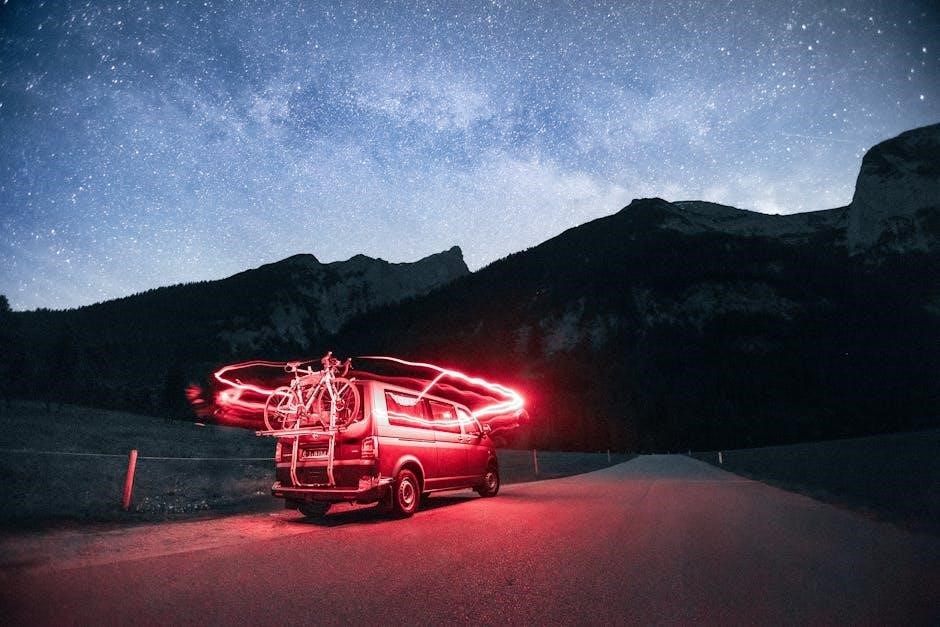
can a manual car have a remote start
Manual cars can have remote start systems installed, offering convenience and comfort. Specialized systems ensure safety and compatibility, addressing unique challenges like gear selection and unintended movement risks.
1.1. Overview of Remote Start Technology
Remote start technology allows drivers to activate their vehicle’s engine from a distance using a key fob or smartphone app. This convenience-enhancing feature is particularly popular in extreme weather conditions, enabling pre-heating or cooling of the car. Modern remote start systems often include advanced features like bi-directional communication, ensuring the vehicle responds to commands. They also integrate with smartphone apps for added control. While primarily a comfort feature, remote start systems can also enhance security and user experience, though manual transmission vehicles require special considerations for safe operation.
1.2. Importance of Remote Start Systems
Remote start systems offer unparalleled convenience, allowing drivers to start their cars from a distance, ensuring optimal temperature inside before entry. This feature is especially valuable in extreme weather conditions, enhancing comfort and reducing wait times. Additionally, remote start systems can improve security by allowing the vehicle to be started in a safe location, deterring theft. They also provide peace of mind and added functionality, making them a sought-after upgrade for many car owners, including those with manual transmissions, despite the unique challenges they present.

Understanding Remote Start Systems
Remote start systems enable drivers to start their vehicles from a distance using a remote control or smartphone app. These systems rely on advanced technology to securely activate the engine, ensuring the car is ready to drive when needed. While primarily designed for automatic vehicles, specialized systems can accommodate manual transmissions with additional safety features to prevent unintended movement or damage.
2.1. How Remote Start Systems Work
Remote start systems use a remote control or smartphone app to send a signal to the vehicle, activating the engine from a distance. The system verifies the signal and ensures the vehicle is in a safe state, such as being in neutral gear for manual cars. Once confirmed, the engine starts, and the vehicle begins to warm up or cool down. Advanced systems like Compustar and Python include features like clutch safety switches to prevent unintended movement in manual cars, ensuring smooth and secure operation.
2.2. Key Components of a Remote Start System
A remote start system consists of a remote control, control module, and wiring harness. The remote sends a signal to the module, which activates the engine. Safety features like a clutch safety switch ensure the vehicle is in neutral before starting. A bypass module integrates with the car’s security system, while a data interface connects to the vehicle’s computer for proper communication. These components work together to ensure reliable and safe operation of the remote start system in manual cars.
Can a Manual Car Have a Remote Start?
Yes, manual cars can have remote start systems, but they require specialized components and safety measures to ensure proper function and prevent unintended vehicle movement or damage.
3.1. Compatibility of Remote Start with Manual Transmissions
Remote start systems can be compatible with manual transmissions, but they require specialized components and safety measures. These systems must ensure the vehicle is in neutral and incorporate features like clutch safety switches to prevent unintended movement. Proper installation is crucial to maintain safety and functionality. While specific brands offer solutions for manual cars, careful consideration of safety precautions and potential modifications is necessary to avoid risks associated with remote starting a manual vehicle.
3.2. Safety Considerations for Manual Cars
Safety is paramount when installing a remote start in a manual car. The vehicle must be in neutral gear to prevent unintended movement. A clutch safety switch is essential to ensure the car doesn’t start in gear, avoiding potential damage to the engine or drivetrain. Proper installation is critical to prevent risks like rollback or accidental engagement. Additionally, measures must be taken to ensure the vehicle remains stationary during remote start, protecting both the car and surrounding environment from harm.

Safety Precautions for Manual Cars with Remote Start
Ensuring the vehicle is in neutral gear, using a clutch safety switch, and preventing unintended movement are critical. These measures protect the engine, drivetrain, and prevent rollback incidents.
4.1. Ensuring the Vehicle is in Neutral Gear
Ensuring the vehicle is in neutral gear is crucial for remote starting manual cars. This prevents unintended movement and potential damage. The clutch safety switch plays a key role, as it prevents the car from starting in gear. Without proper neutral positioning, the car might lurch, risking engine and drivetrain damage. Always confirm neutral gear before remote starting to maintain safety and avoid accidents.
4.2. Role of the Clutch Safety Switch
The clutch safety switch ensures the vehicle cannot start unless the clutch pedal is fully pressed, a critical safety feature for manual cars. When installing a remote start system, this switch must be bypassed to allow starting without physical interaction. Improper bypassing can lead to unintended movement or damage. The switch prevents accidental starts in gear, making it essential for safe remote start operation in manual vehicles. Proper installation by professionals is vital to maintain safety and functionality.
4.3. Preventing Unintended Vehicle Movement
Preventing unintended movement is crucial for manual cars with remote start. Ensuring the vehicle is in neutral gear and engaging the parking brake are essential steps. Modern remote start systems often include fail-safes, such as checking the gear position and clutch status, to prevent accidental movement. Additional measures like wheel locks or advanced software checks can further enhance safety. Proper installation and configuration are vital to eliminate risks of the vehicle rolling or lurching unexpectedly when the engine starts remotely.
4.4. Engine and Drivetrain Protection
Protecting the engine and drivetrain is vital when installing a remote start in a manual car. Remote start systems must ensure the vehicle is in neutral gear before ignition to prevent sudden lurching, which can damage components. Specialized modules monitor gear position and clutch status, halting the start sequence if conditions are unsafe; These protections minimize mechanical stress and potential damage, ensuring long-term reliability of the engine and drivetrain while maintaining smooth operation.
4.5. Rollback Prevention Measures
Preventing rollback is crucial for manual cars with remote start. Systems ensure the vehicle remains stationary by confirming neutral gear and engaging the parking brake automatically. Advanced mechanisms detect any unintended movement, halting the engine if rollback is sensed. These measures safeguard against accidents and damage, especially on inclines. Supplementary safety features, like brake pulse technology, further enhance stability and control, ensuring the vehicle stays secure when started remotely.

Installation Considerations
Professional installation is recommended for manual cars to ensure compatibility and safety. Experts assess vehicle-specific requirements and implement necessary safety protocols to prevent unintended movement or damage.
5.1. Professional Installation Recommendations
Professional installation is crucial for remote starts in manual cars. Experts ensure systems are configured to prevent accidental starts in gear, protecting the engine and drivetrain. They assess specific vehicle requirements, install safety mechanisms like neutral gear confirmation, and bypass the clutch safety switch securely. Proper installation prevents potential risks and ensures reliability, making it essential to hire qualified technicians for the job. Their expertise guarantees a seamless and safe remote start experience for manual transmission vehicles.
5.2. Necessary Modifications for Manual Cars
Manual cars require specific modifications for remote start systems. These include bypassing the clutch safety switch to allow starting without pressing the clutch. Additional components like neutral gear confirmation sensors ensure the vehicle is in a safe state before starting; These modifications prevent unintended movement and potential damage to the engine or drivetrain. Compatible remote start brands, such as Compustar and Python, are designed to work with manual transmissions, ensuring safe and reliable operation. Proper modifications are essential for a functional remote start system in manual vehicles.
Compatible Remote Start Brands for Manual Cars
Compustar and Python are top remote start brands designed for manual cars, ensuring safe and reliable operation with specialized features for manual transmissions.
6.1. Compustar Remote Start Systems
Compustar offers advanced remote start solutions for manual cars, ensuring safety and reliability. Their systems feature specialized components like neutral gear detection and clutch safety switches. These technologies prevent accidental movement by verifying the vehicle is in a safe state before starting. With a user-friendly interface and robust range, Compustar systems are popular among enthusiasts. They are designed to integrate seamlessly with manual transmissions, offering convenience without compromising safety. Installers often recommend Compustar for its durability and compatibility with various vehicle makes and models.
6.2. Python Remote Start Systems
Python remote start systems are highly regarded for their reliability and compatibility with manual cars. Designed with advanced safety features, Python systems ensure the vehicle is in a secure state before ignition. They offer a user-friendly interface, long-range connectivity, and seamless integration with manual transmissions. Python’s technology prevents unintended movement by verifying the car’s neutral gear position. Enthusiasts and installers favor Python for its durability and ease of use. Their systems provide a convenient and secure remote starting solution for manual vehicles, enhancing the driving experience without compromising safety.

Advantages of Remote Start for Manual Cars
Remote start systems offer unmatched convenience, allowing manual car owners to pre-heat or cool their vehicle. Enhanced security features and seamless integration with manual transmissions further improve the driving experience.
7.1. Convenience and Comfort
Remote start systems provide unparalleled convenience for manual car owners, allowing them to start their vehicle from a distance. This feature is especially beneficial in extreme weather, eliminating the need to brave freezing temperatures or oppressive heat. With a simple press of a button, the engine roars to life, ensuring the cabin reaches a comfortable temperature before entry. Additionally, remote start systems can be integrated with modern smartphones, offering an added layer of accessibility and control. This seamless functionality enhances the overall driving experience, making daily commutes more enjoyable and stress-free.
7.2. Enhanced Security Features
Remote start systems for manual cars often include advanced security features that enhance vehicle protection. These systems typically integrate with car alarms and immobilizers, ensuring the vehicle remains secure even when started remotely. Many modern models offer encryption and rolling code technology to prevent unauthorized access. Additionally, some systems provide notifications for unauthorized attempts to start or move the vehicle, offering peace of mind to owners. These security enhancements make remote start systems a valuable addition for manual car owners seeking both convenience and safety.

How Remote Start Technology Works for Manual Cars
Remote start technology for manual cars involves transmitting a signal to activate the engine, ensuring the vehicle is in neutral and clutch safety protocols are met.
8.1. Activation Process and Signal Transmission
The activation process begins with the user pressing a button on the remote fob, sending a radio frequency signal to the vehicle’s receiver. This signal is decoded and verified for authenticity before initiating the start sequence. The system ensures the vehicle is in a safe state, typically in neutral gear with the clutch disengaged, preventing unintended movement. Modern systems often use encrypted signals for enhanced security, while some advanced models may utilize smartphone app integration for added convenience and control.
8.2. Vehicle Response and Safety Checks
Upon receiving the remote start signal, the vehicle performs a series of safety checks. It verifies that the transmission is in neutral and the clutch is disengaged to prevent unintended movement. The system ensures all necessary conditions are met before initiating engine startup. Advanced remote start systems, such as those from Compustar and Python, incorporate additional safety features, including rollback prevention and automatic shut-off if any irregularities are detected. These measures ensure safe and reliable operation of the remote start function in manual vehicles.

Potential Risks and Challenges
Improper installation can cause mechanical issues or unintended movement. Ensuring the vehicle is in neutral and the clutch is disengaged is critical to avoid risks.
9.1. Possible Issues with Improper Installation
Improper installation of a remote start in a manual car can lead to unintended movement or engine damage. If the vehicle isn’t properly placed in neutral or the clutch safety switch isn’t bypassed correctly, the car may lurch forward unexpectedly. This can result in accidents or mechanical damage. Additionally, faulty wiring or incorrect system configuration may disable safety features, increasing the risk of accidents. Proper installation techniques and adherence to manufacturer guidelines are essential to avoid these issues and ensure safe operation.
9.2. Risks of Unintended Movement
One of the primary risks with remote starts in manual cars is unintended movement. If the vehicle isn’t properly secured in neutral or the clutch safety switch isn’t bypassed correctly, the car may lurch forward or roll unexpectedly. This can lead to accidents, especially if the vehicle is parked in a confined space or near others. Proper installation is crucial to ensure the system confirms the car is in a safe state before starting the engine. Without these safeguards, unintended movement poses a significant safety hazard.

Legal and Regulatory Considerations
Check local laws regarding remote start systems, as regulations vary. Ensure compliance with safety and emissions standards. Some jurisdictions may require specific certifications or insurance adjustments for such installations.
10.1. Local Laws and Regulations
Local laws vary widely regarding remote start installations. Some regions require explicit permission for aftermarket systems, while others have strict safety standards. Ensure your system meets local regulations to avoid penalties. Compliance with noise ordinances and emissions standards is crucial. Additionally, certain areas may restrict remote starting due to environmental concerns or theft prevention measures. Always consult local authorities before installation to confirm legal requirements and avoid potential fines or system removal.
10.2. Insurance Implications
Installing a remote start in a manual car may have insurance implications. Some insurers require proof of professional installation to maintain coverage. Aftermarket systems, especially those with enhanced security features, might qualify for premium discounts. However, improper installation or unauthorized modifications could void your policy. Always notify your insurer about the remote start system to ensure compliance and avoid coverage issues. Additionally, check if your provider offers specific clauses for aftermarket remote start installations in manual vehicles.

User Experiences and Reviews
Users report high satisfaction with remote starts in manual cars, citing convenience and comfort. Installers emphasize proper installation to avoid issues, ensuring reliability and safety.
11.1. Real-Life Examples of Manual Cars with Remote Start
Owners of manual cars, such as BMW and Subaru models, successfully use remote start systems. These systems, like Compustar and Python, ensure vehicles start safely in neutral gear. Users appreciate the convenience of pre-heating or cooling their cars without physical key access. Proper installation by professionals is crucial to avoid drivetrain damage or unintended movement. Positive reviews highlight enhanced comfort and security, proving remote starts are viable for manual transmissions when installed correctly.
11.2. Feedback from Installers and Enthusiasts
Installers and enthusiasts report positive experiences with remote starts in manual cars. Professionals highlight the importance of proper installation to prevent engine damage. Enthusiasts praise the convenience and comfort, especially in extreme weather. Many recommend brands like Compustar and Python for their reliability and safety features. Some note the need for clutch bypass and neutral gear confirmation. Overall, the consensus is that remote starts enhance manual car ownership when installed correctly, offering a blend of functionality and peace of mind for drivers.
Remote start systems are compatible with manual cars, offering convenience and comfort. Proper installation and safety features like clutch safety switches are essential to prevent unintended movement and ensure functionality. While there are risks, such as potential engine damage if not set up correctly, many users and professionals recommend reputable brands like Compustar and Python. Overall, a remote start can enhance the driving experience for manual car owners when installed accurately and responsibly.
12.1. Final Thoughts on Remote Start for Manual Cars
Remote start systems can be successfully installed in manual cars, offering enhanced convenience and comfort. While installation requires careful consideration of safety features like clutch safety switches and neutral gear confirmation, the benefits outweigh the challenges. Reputable brands such as Compustar and Python provide reliable solutions tailored for manual transmissions. Proper installation by professionals ensures functionality and safety, making remote start a viable and appealing option for manual car owners seeking modern convenience without compromising vehicle integrity or performance.

Frequently Asked Questions (FAQ)
Yes, manual cars can have remote starts with specific systems designed for them, ensuring safety and proper functionality when installed correctly by professionals for optimal performance and reliability.
13.1. Is It Safe to Install a Remote Start in a Manual Car?
Installing a remote start in a manual car is safe if done correctly. It requires specialized systems to prevent unintended movement and engine damage. Professional installation ensures all safety features, like neutral gear verification and clutch safety switches, are properly integrated. This minimizes risks and ensures the vehicle operates securely when started remotely, providing peace of mind for drivers who want convenience without compromising safety.
13.2. Can I Install a Remote Start Myself?
Installing a remote start in a manual car is possible but challenging. It requires technical knowledge and specialized tools to ensure proper integration with the vehicle’s systems. While DIY installation can be done, it is not recommended due to the complexity of bypassing the clutch safety switch and ensuring the vehicle is in neutral gear. Professional installation is highly advised to avoid potential risks, such as unintended movement or engine damage, and to ensure the system functions safely and reliably.
13.3. What Brands Are Best for Manual Cars?
Compustar and Python are highly recommended brands for remote start systems in manual cars. Both offer specialized solutions designed to address the unique challenges of manual transmissions, ensuring safety and functionality. Compustar systems are known for their compatibility with almost any manual vehicle, while Python provides advanced features and reliability. These brands are trusted by installers and enthusiasts for their performance and ability to prevent unintended movement, making them top choices for manual car owners seeking remote start capabilities.